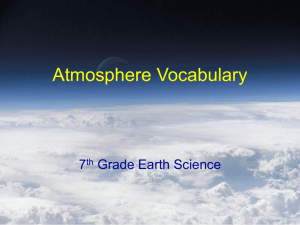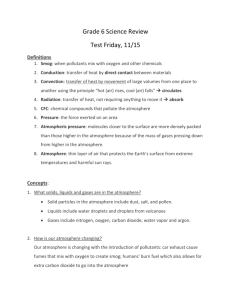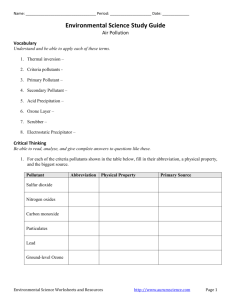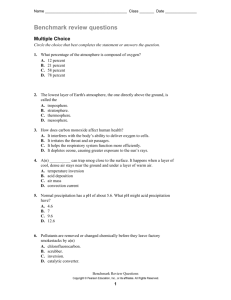Air Pollution Chapter 19
advertisement
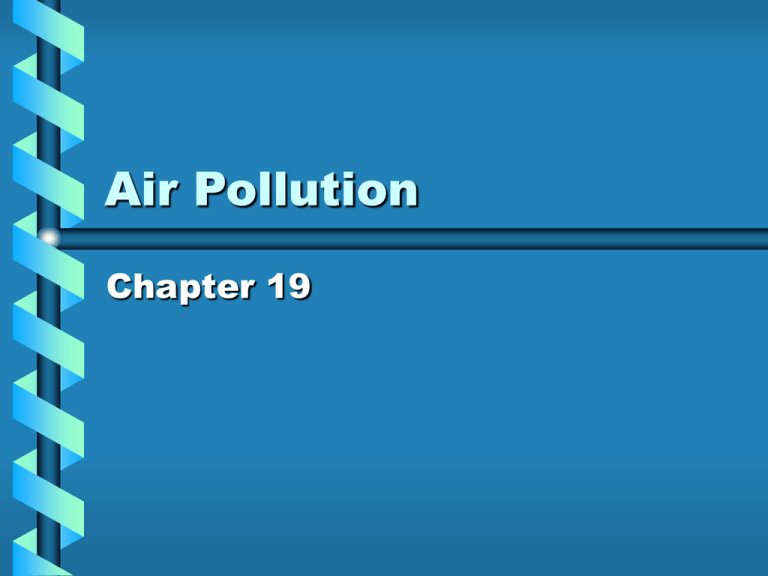
Air Pollution Chapter 19 Atmosphere Quiz • Name the five layers of the atmosphere • What are the four main gases found in air other than water? • Name three primary air pollutants • Name three secondary air pollutants Five layers of the atmosphere • Troposphere – – – – – Densest, 11 miles thick Air cools with increased altitude Ozone is poisonous here Planes fly here Weather occurs here Five layers of the atmosphere • Stratosphere – From 11 miles to 30 miles up from earth – Temperatures rise with increased altitude – Contains ozone layer Ozone layer • Blocks out 95% of UV radiation – Allows life to exist – Prevents sunburn/cancer of skin – Prevents oxygen in troposphere from converting into toxic ozone Five layers of the atmosphere • Mesosphere – middle layer, air cools with increased altitude • Thermosphere – air warms with increased altitude • Exosphere – air cools with increased altitude, blends to space What is in air • • • • 78% nitrogen 21% oxygen 1% argon < .1% carbon dioxide What does our atmosphere do? • Two main natural processes – Greenhouse effect – keeping the planet warm through absorbing long wave radiation from the planet (water, CO2, CH4) – Ozone shield – blocking unwanted UV radiation Primary pollutants • • • • • • • CO – carbon monoxide CO2 – carbon dioxide SO2 – sulfur dioxide NO – Nitric oxide NO2 – Nitrogen dioxide Hydrocarbons particulates Primary pollutants • Can be natural (volcano) but most are human released • Cars, industrial plants and power plants (especially coal) are main sources • When primary pollutants mix in air some form new secondary pollutants Secondary Pollutants • • • • • • SO3 – sulfur trioxide HNO3 – nitric acid H2SO4 – sulfuric acid H2O2 – hydrogen peroxide O3 - ozone PANs – peroxyacyl nitrates Human impact • We are altering natural balance of cycles in the atmosphere – Add ¼ more carbon dioxide (global warming) – Burn fossil fuels and use fertilizers releasing NOx into the air creating more acid rain (nitric acid) – Add sulfur to air from burning coal and refining petroleum (sulfuric acid) That’s only the beginning • Heavy metals – 2x the arsenic as nature releases – 7x the cadmium – 17x the lead It is hard to judge the effect on particulates, but we release large amounts of ash and dust Photochemical smog • Brown smog • Mostly Ozone, aldehydes, PANs and Nitric acid formed from NOx from cars/factories and volatile organic compounds (CH4, propane, benzene, CFCs) mixing in the presence of sunlight Smog chemistry • N2 + O2 = 2NO (engine of car) – Then in the air • 2NO + O2 = 2NO2 (brown haze) – Gives choking odor • 3NO2 + H2O = 2HNO3 + NO – Produces acid rain and some NO2 goes on to react this way • NO2 + UV = NO + O which then • O + O2 = O3 (ozone) More smog • Collectively NO2, O3, and PANs are known as chemical oxidants because they react easily with other compounds or in your lungs • Very small (trace) amounts can irritate respiratory tracts or damage crops/vegetation Industrial smog • Known as gray-air smog • Mostly SO2 and H2SO4 as well as suspended particles (ash) • Mostly caused by burning coal, but can be prevented with controls (scrubbers, etc.) When smog is a real problem • Thermal inversion – a layer of warm air sits on top of a cold layer trapping pollutants that would normally disperse. This causes air pollutants to rise to harmful or deadly levels Ughh! • Enough bad news for one day. Industrial smog • • • • • C + O2 = CO2 and CO and soot S + O2 = SO2 2SO2 + O2 = 2SO3 SO3 + H2O = H2SO4 H2SO4 + 2NH3 = (NH4)2SO4 (salt) + soot give the gray color Acid deposition • Acid rain – wet acid • Acid deposition – dry acid (solid or a gas) • Natural rain is pH 5 – 5.6 (without acid) CO2 is dissolved from air forming weak carbonic acid Who/Where is affected? • Areas that are downwind from industrial or dense urban zones are in greatest risk of damage due to acid deposition • Vegetation and aquatic life receive most of the damage Acid protection • Natural buffers in soil – Ca+ and Mg+ can react and neutralize acids. • Thin acidic soils offer no buffering Acid production • Factories, power plants, smelters and cars produce the most acid • Acid crosses large distances via the wind and can still damage “clean” nations/areas Acid associated problems • Humans – respiratory (bronchitis and asthma) • Buildings – premature aging • Trees – weakens leaves, disease pest can then kill tree • Soil – release metals (toxic) like aluminum (3rd most abundant element in crust) which can kill fish by producing excess mucus Acid associated problems continued… • Aquatic – release methylmercury from natural mercury which accumulates to toxic levels in fish Acid prevention • Reduce energy use • Switch from coal to cleaner energy sources • Remove sulfur from coal before burning • Remove SO2, NOx and particulates from smokestacks with scrubbers • Remove NO2 from car exhaust More acid cleanup • Limestone can be added to lakes to neutralize acid, but it is hard to determine how much and liming can kill some organisms Let’s step inside • Indoor air pollution – – – – – – – – – Carbon monoxide Asbestos Nitrogen oxide Trichloroethane (aerosols, dry cleaning) Chloroform (chlorine in hot water) Radon (gas from uranium-238) Tobacco smoke Formaldehyde – particle board, furniture Styrene – carpet, plastics What does it do • • • • • Smoke – cancer, asthma, bronchitus CO – dizziness, headache, heart attack Pm10 – respiratory disease, cancer SO2 – restricted airway NO – lung irritation, asthma, encourage spread of cancer • VOCs (benzene and formaldehyde) and toxic particulates (lead, cadmium, PCB, dioxins) – mutations, reproductive problems Ozone hurts trees • As well as harming humans in the troposphere, ozone affects plants and trees • • • • Damage to leaves through pores Reduced wax coating Reduced photosynthesis Reduced nutrient uptake Regulation/protection • Clean air act – Sets nation limits for seven pollutants – pm10, SO2, CO, Nox, O3, VOCs, and lead – Also prevents significant deterioration in any area – EPA set levels for 302 individual compounds and 20 categories of toxic compounds Improving the Laws • Switch from cleanup to prevention • Conservation/alternate energy sources (no fossil fuels) • Stricter emission standards • Eliminate trash incineration Emission controls for smokestacks • • • • Electrostatic precipitator Baghouse filter – good for pm10 Cyclone separator Wet scrubber • All collect toxic solids which then must be disposed of as hazardous waste Reducing indoor air pollution • Better venting • In developing countries – better stoves, no smoke in the house • Use natural fibers • Reduce use of household cleaners with harsh chemicals • No dry cleaning
